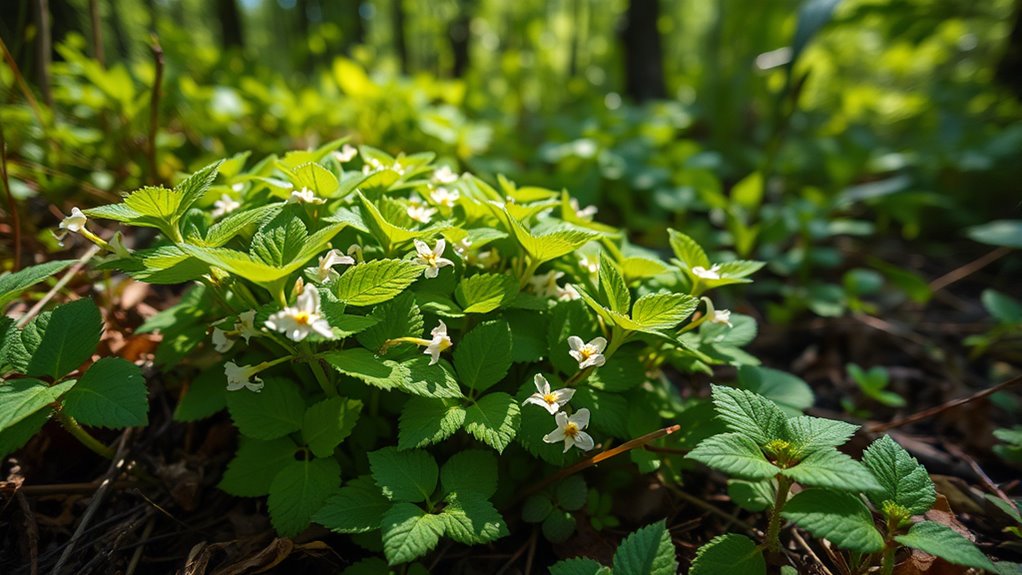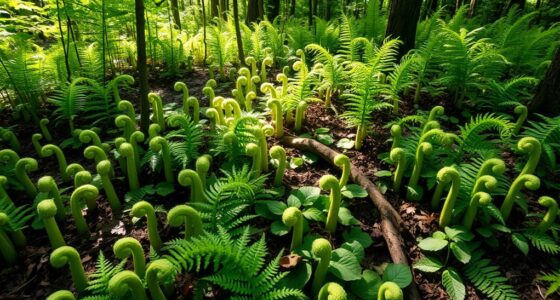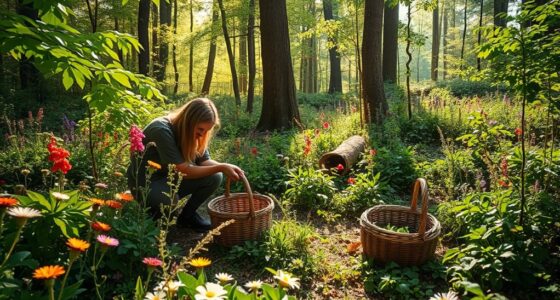Eating invasive plants like garlic mustard, Japanese knotweed, and Eurasian watermilfoil can help control their spread and support ecosystem health. By responsibly identifying and harvesting these plants, you contribute to habitat restoration, reduce pollution, and support native species. Proper preparation makes these invasives safe and tasty additions to your meals. If you keep exploring, you’ll discover how to identify, harvest, and use these plants effectively to benefit your environment and community.
Key Takeaways
- Edible invasive plants like garlic mustard and Japanese knotweed can be harvested to reduce their spread and support native ecosystems.
- Proper identification and sustainable harvesting practices prevent harm to native species and ensure ecological balance.
- Incorporating invasive plants into meals through sautéing or blending helps control their dominance while providing nutritious food options.
- Removing invasive species through foraging and community efforts promotes habitat restoration and biodiversity.
- Educating others about edible invasives encourages responsible harvesting and supports ecosystem health initiatives.
Understanding Invasive Species and Their Impact

Have you ever wondered how some plants become invasive and disrupt local ecosystems? It often starts with their ability to spread rapidly, outcompeting native species. This invasive spread is fueled by factors like pollution impact, which can weaken native plants and give invasive species an advantage. When pollution contaminates soil and water, it alters the environment, making it easier for invasive plants to establish themselves. These species often have traits like high reproductive rates and adaptability, allowing them to thrive in disturbed areas. As they spread unchecked, they displace native flora, reducing biodiversity. Understanding how invasive species spread and how pollution impacts their growth helps you recognize the importance of managing these plants. Controlling their spread protects ecosystems and preserves native plant and animal life. Additionally, the high reproductive rates of invasive plants enable them to quickly dominate new areas, further threatening native species and ecosystem stability.
Common Edible Invasive Plants in North America
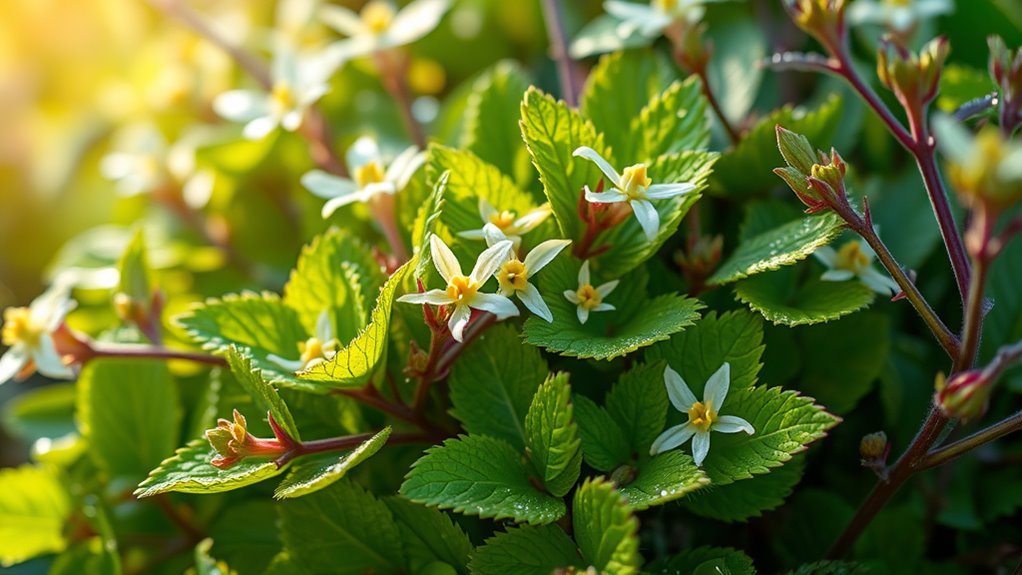
Did you know that some invasive plants, despite their disruptive impact on ecosystems, can actually be safely harvested and enjoyed as food? Common edible invasive plants in North America include garlic mustard, Japanese knotweed, and eurasian watermilfoil. These plants are not only abundant but also nutritious, making them appealing for foraging. When collecting edible invasive plants, it’s essential to follow foraging ethics—harvest sustainably, only take what you need, and avoid contaminations. Proper identification is critical to ensure you’re harvesting the right species. Incorporating these invasive plants into your diet can help control their spread while benefiting your health. Always respect local regulations and environmental guidelines to help protect ecosystems while enjoying these versatile, invasive species.
Identifying and Harvesting Invasive Plants Safely
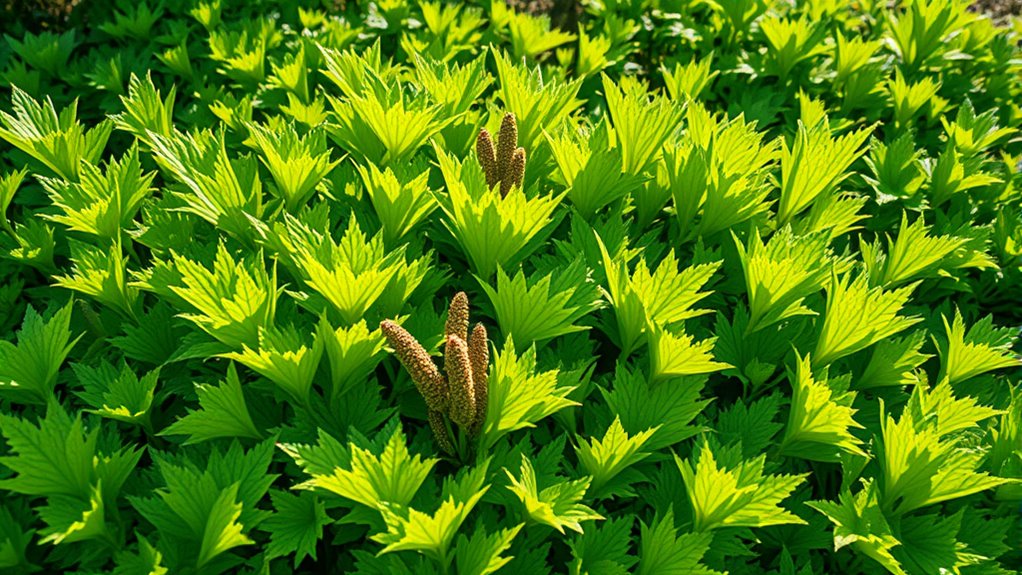
When foraging for invasive plants like garlic mustard, Japanese knotweed, or Eurasian watermilfoil, correctly identifying each species is essential to avoid accidental poisoning or damaging native ecosystems. Understanding invasive plant ecology helps you recognize these plants safely. To guarantee safe harvesting, follow these steps:
Accurate identification ensures safe harvesting and protects native ecosystems when foraging invasive plants.
- Learn key features of edible plant identification, such as leaf shape, stem color, and flower structure.
- Consult reliable resources like field guides or local experts to distinguish invasive from native species.
- Check for look-alikes that may be toxic or protected, avoiding any uncertain plants.
- Harvest responsibly, taking only what you need and leaving enough to support the ecosystem.
- Recognize the benefits of proper identification, such as supporting personal development by engaging in mindful foraging practices that enhance your connection to nature.
Proper identification safeguards your health and supports invasive plant management efforts.
Recipes and Preparation Tips for Invasive Edibles

Once you’ve harvested invasive plants safely, you can start experimenting with different recipes and flavor combinations. Proper harvesting techniques guarantee you get the best quality and minimize waste. Try sautéing, blending into smoothies, or adding herbs to your favorite dishes to enjoy their unique tastes. Incorporating culinary uses of chia seeds can inspire creative ways to enhance texture and nutrition in your dishes.
Harvesting Techniques and Tips
To guarantee you harvest invasive plants safely and sustainably, it’s important to use proper techniques that preserve the plant’s quality and prevent damage. This is essential for harvesting safety and ensuring sustainable foraging practices. Here are four tips to help you succeed:
- Always identify plants correctly before harvesting to avoid harmful look-alikes.
- Use clean, sharp tools to cut plants, minimizing injury and promoting healthy regrowth.
- Harvest only what you need, leaving enough behind for the plant’s future growth and local wildlife.
- Avoid pulling out entire plants; instead, selectively pick leaves or stems to prevent overharvesting.
Cooking and Flavor Ideas
Invasive plants can be a nutritious and flavorful addition to your meals when prepared correctly. To enhance their natural flavors, focus on smart flavor pairings—try combining invasive greens with garlic, lemon, or chili for a bright, fresh taste. Cooking methods vary; sautéing, steaming, or blanching preserve texture and nutrients, while adding herbs and spices elevates the dish. For instance, wild garlic can be used in pesto or soups, while young shoots of invasive plants like Japanese knotweed work well in stir-fries or pies. Experiment with different techniques to discover what suits each plant’s unique flavor profile. Remember, balancing flavors is key to turning invasive edibles into delicious, eco-friendly meals that support your local environment. Additionally, understanding tuning options can help you prepare these plants for optimal flavor and nutritional value.
Environmental Benefits of Removing and Eating Invasive Species

Removing and eating invasive species offers significant environmental benefits by directly reducing their spread and dominance in native ecosystems. When you harvest these plants, you help curb pollution caused by invasive overgrowth and contribute to habitat restoration. Your efforts can:
Harvesting and eating invasive species helps restore native ecosystems and reduces pollution.
- Decrease pollution levels by removing plants that contribute to soil and water contamination.
- Promote native species recovery, restoring balanced ecosystems.
- Reduce invasive plant spread, preventing further habitat loss.
- Support biodiversity by giving native plants a chance to thrive again.
Engaging with invasive plants also raises awareness about dream symbols, encouraging a deeper understanding of nature’s interconnectedness and the importance of ecological balance.
Legal Considerations and Ethical Harvesting Practices

While harvesting invasive plants can benefit ecosystems, it’s essential to be aware of legal restrictions and ethical guidelines. Laws vary by region, so you should check local regulations before collecting any plants. Some areas prohibit removal without permits to prevent unintended ecological harm or illegal trade. Following ethical guidelines means harvesting sustainably—never overharvest, leave enough for wildlife, and avoid damaging native species or habitats. Respect private property and always seek permission if needed. Be mindful of invasive species identification to prevent accidental removal of native plants. Practicing responsible harvesting guarantees you help control invasives without causing new problems. Staying informed about legal and ethical considerations protects ecosystems and supports your efforts to contribute positively to environmental health.
How You Can Contribute to Ecosystem Restoration

You can play a direct role in restoring ecosystems by actively participating in the removal of invasive plants and supporting native species. One way is through wild food foraging, which encourages you to harvest invasive plants responsibly, reducing their spread while providing food. Engaging in invasive plant management helps limit their dominance and promotes native biodiversity. To contribute effectively, consider these actions:
Participate in invasive plant removal and support native species through responsible foraging and community efforts.
- Identify and target invasive species in your area.
- Forage for edible invasive plants to remove them sustainably.
- Volunteer with local conservation groups for invasive removal projects.
- Educate others about invasive plant impacts and edible options.
- Incorporate advanced fraud detection techniques to better safeguard your efforts from potential scams or fraudulent activities related to conservation initiatives.
Frequently Asked Questions
Are All Invasive Plants Safe to Eat?
You might wonder if all invasive plants are safe to eat, but safety isn’t guaranteed. Some invasive plants have toxicity concerns that could harm you, so never assume they’re edible. However, many invasive species boast culinary versatility, making them an eco-friendly food source. Always research thoroughly or consult an expert before trying any new plant. You can help the environment while enjoying their unique flavors if you choose wisely.
How Do I Ensure Sustainable Harvesting Practices?
To guarantee sustainable harvesting practices, you should first check local harvesting regulations to stay within legal limits. Always harvest responsibly by taking only what you need, avoiding overharvesting, and leaving enough for the ecosystem’s health. Be mindful of the ecological impact, ensuring your actions support plant populations and wildlife. Educate yourself on the plant’s growth cycle and harvest during the appropriate season to promote resilience and sustainability.
Can Eating Invasive Plants Eliminate Their Spread?
A stitch in time saves nine, and that applies here. Eating invasive plants can help control their spread, but it’s not a guaranteed solution. Foraging safety is vital to avoid toxins, and recognizing culinary versatility guarantees you use the plants correctly. While harvesting invasive species can reduce their numbers, it’s best paired with other control methods for lasting impact. Rely on expert guidance to keep it safe and effective.
What Tools Are Best for Harvesting Invasive Species?
When it comes to harvesting invasive species, using the right invasive plant tools makes a big difference. You should focus on effective harvesting techniques, such as hand tools like shears, pruners, or weed pullers, to remove plants carefully and efficiently. These invasive plant tools help you reduce damage to native plants and guarantee thorough removal. Always wear gloves and use sharp, sturdy tools to make the process safer and more successful.
How Do I Identify Invasive Plants in Winter?
Identifying invasive plants in winter is like spotting a familiar face in a winter landscape. You focus on dormant plant features such as unique bark patterns, distinctive seed heads, or unusual leaf scars. Look for plants that stand out from native species, like invasive grasses with stiff stems or shrubs with distinctive branching. Winter identification requires keen observation of these dormant features, helping you recognize invasive species even when they’re not actively growing.
Conclusion
By eating invasive plants, you’re turning a thorn in the ecosystem into a tool for renewal. Think of yourself as a gardener, wielding a fork instead of a shovel, helping nature reclaim its balance. Each bite you take is like planting seeds of change, removing threats and nourishing the environment. Together, your actions can transform invasive species from problems into solutions, guiding the landscape back to health—one delicious meal at a time.

